Notes on Women Who Rock: Making Scenes, Building Communities: Participatory Research, Community Engagement, and Archival Practice
by Michelle Habell-Pallán, Sonnet Retman, and Angelica Macklin
published July 2014
“Unless you document your work, it’s as though it never existed.”
--Alicia "Bag" Velasquez, Women Who Rock oral history
“If you aren’t seeing women, not seeing people of color, that means it’s up to us to document…"
--Medusa, Women Who Rock 2013 panel transcript

1. Aims
Since 2011, Women Who Rock (WWR) has brought together scholars, archivists, musicians, media-makers, performers, artists, and activists to explore the role of women and popular music in the creation of cultural scenes and social justice movements in the Americas and beyond. The project promotes generative dialogue and documentation by “encompassing several interwoven components: project-based coursework at the graduate and undergraduate levels; an annual participant-driven conference and film festival; and an oral history archive hosted by the University of Washington Libraries Digital Initiatives Program that ties the various components together” (Bartha 8). In our courses, programming, and archive, we examine the politics of performance, social identity, and material access in music scenes, cultures, and industries. Performance studies scholar Daphne Brooks argues that the “confluence of cultural studies, rock studies, and third wave feminist critical studies makes it possible now more than ever to continue to critique and re-interrogate the form and content of popular music histories” (58). WWR implements this approach, asking how particular stories of popular music determine a performer, band, or scene’s “legendary” status or excision from the official annals of memory. WWR reshapes conventional understandings of popular music studies by initiating collective methods of participatory research, as well as community collaboration and dialogue. By way of WWR, we seek to transform traditional models of popular music studies, instigating new convergences between academic disciplines and critical approaches that create alternative histories and new forms of knowledge.
Within WWR, the digital realm helps propel this epistemological transformation. In their essay, “Can Digital Humanities Mean Transformative Critique?,” digital scholars Alexis Lothian and Amanda Phillips ask:
What would digital scholarship and the humanities disciplines be like if they centered around processes and possibilities of social and cultural transformation as well as institutional preservation? If they centered around questions of labor, race, gender, and justice at personal, local, and global scales? If their practitioners considered not only how the academy might reach out to underserved communities, but also how the kinds of knowledge production nurtured elsewhere could transform the academy itself? (5)
Lothian and Phillips cite WWR as a living model of transformative collective and collaborative feminist-of-color critique, an affirmative response to their lead question regarding the work of the digital humanities in creating new models of community-based, politically-engaged knowledge production (9-10). In the following sections, we walk through the challenges and rewards of the WWR project in the on-going process of its evolution.
2. Model
The form of our exploration and its accompanying archive is just as significant as its aim. As the project deploys collaborative and synergistic methods of conducting popular music research, it advances a critical praxis that centers community-based knowledge production. To paraphrase new media scholar Tara McPherson in her WWR oral history, we flip the digital script by utilizing technology to build human infrastructure. Chicana and women of color feminist epistemologies, queer of color theorizing and feminista media frameworks provide the foundation for the project.
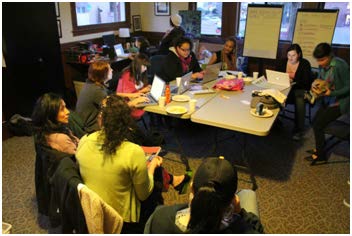
As we have developed each of the project’s components, we have sought to transform conventional classroom and conference spaces and formats to foster generous, collaborative, and organic intellectual work. WWR bridges our rootedness in social justice communities, whose deep histories have influenced “interactive, immersive, and multimedia expression,” to “our own thinking and scholarship” (McPherson 120). Performance scholar Tiffany Ana Lopez writes that the 2011 conference:
staged conversation so as to inspire and foster future engagement and collaboration beyond the events. Program organization proved absolutely vital to the success of the conference and represented an ideal model for all of us to consider as it yielded one of the most productive, inspiring, and meaningful conference experiences in my twenty years attending such events. We often lose sight of the university as a place of possibility as well as privilege. It is the space of possibility that the conference organizers consistently embraced and opened up with their adamant positioning of the university as a visionary meeting ground. (199)
In our conference program, we state: “we intend to create an open structure through which unexpected, transformative and even healing conversations might emerge. We look forward to engaging in rich dialogues and laying the foundation for new kinds of communities.” In Lopez’s summation, WWR “experimented with a conference structure that avowedly emphasized dialogue and made scenes.”
This emphasis on dialogue, experimentation, and open structure has helped us navigate tensions that have sometimes arisen in our organizing activities. We all come from different locations within the university and the community—we are professors, graduate students, undergraduates, media scholars, filmmakers, musicians, artists, community organizers, librarians, archivists, and more. Each of us brings to the project different training, technological skills and interests, resources, and time commitments. When we first began the collaboration among the University of Washington, Seattle University, and community arts and social justice organizations such as Ladies First and Seattle Fandango, there were occasionally misperceptions about the amount of resources available from the university and also the aims of the university-affiliated people involved in the project. Community partners feared that the university might co-opt their work. As the project continues, we strive to be aware of our varying degrees of institutional and personal power in our interactions with each other and in the project’s structure and workflow.
This is an ongoing, self-reflexive process, challenging and time-consuming but central to the WWR’s feminist ethos. It has shaped the everyday life of the project. For example, to organize the second conference, over the course of nine months we met weekly at Washington Hall, a historic community arts and performance space in Seattle’s Central District, intentionally moving our planning sessions to a community space outside of the university. On most Sundays, an ad hoc group of people gathered, kids often in tow, to do things like devise wording for our mission statement, craft a call for papers on a Google doc, and map out the structure and scope of our programming. We divided up writing assignments, interview transcriptions, the film editing of oral histories, and other tasks. In those meetings, we also addressed various tensions around the project’s resources and issues of labor and stewardship, fostering collaborative working relationships and friendships. The everyday life of the project, then, includes these conversations along with production sessions, curriculum preparation, student recruitment and advising, participation in community and university workshops, attending performances, and hanging out. In the past years, we have spent a good deal of time together, bridging communities that overlap and intersect, such as Seattle Fandango, a participatory dance and music community, and DE CAJóN Project, an Afro-Peruvian dance, music, and education collective. In so doing, we have made our own scene.
This scene has grown more expansive with the launch of the WWR Digital Oral History Archive. Crucially, the archive functions as a public repository, a space where many communities can freely access these interviews and draw upon them to produce new media and scholarship. Though it might be expected that a project of this sort would face obstacles at the intersection of technological and cultural practices—skepticism around technology or digital work, for example, or a sense that technical work is not cultural work—we have not encountered this in our collaborations between the university and community arts and social justice organizations. Many of the women who have been interviewed for the project are enthusiastic about the ways that this technology might function to preserve and tell different stories about their work and lives. Many of the project’s community partners have led the way in effectively utilizing social media. Some of us who work at the university have faced issues around our own professional evaluation with regard to WWR and digital humanities, namely that this project isn’t legitimate scholarly or community work. For us, though, our primary question is how we can best use technology to move our cultural project forward.
When we began the project, its three planks developed organically: we taught a class in which students produced oral histories with artists and activists, and we organized a graduate mentoring workshop and conference that dovetailed with the class. We did not begin with designated roles beyond teacher, student, and organizer; moreover, we did not have a clear workflow plan in place. The Simpson Center funded the conference and assigned musician and organizer Quetzal Flores to our project as a liaison. Sociologist and hip hop scholar Dr. Mako Fitts Ward was a partner in the development of the first conference and became a co-founder of the WWR collective. We began working closely with long-time community organizer Luzviminda (Lulu) Uzuri Carpenter, who now sits on the WWR Community Advisory Board. Graduate students like Kim Carter Muñoz, Monica De La Torre, Carrie Lanza, Angelica Macklin, Rinna Rem, Nicole Robert, and Iris Viveros transformed the project with their expertise in digital media production, project management, ethnography, curation, and community building. WWR allows all of us to hone our skills and create individual and collaborative work within and beyond the project’s purview. We are gaining clarity about our various roles and our workflow as we move forward. Like many public digital humanities projects, issues of labor, scale, and sustainability are our most pressing challenges.
3. Curriculum
Our classes explore the central role of women and popular music in the creation of communal scenes and social justice movements, and in personal and collective narratives of memory and history. In 2010-2011, with a grant from the American Music Partnership of Seattle (AMPS), we created a course for undergraduate and graduate students that investigated the politics of gender and performance in music scenes, “Making a Scene: Girls and Boys Play Indie Rock.” In the process, we developed a multi-level approach to mentoring graduate and undergraduate students via oral history training. This course supported the creation of a digital oral history archive that includes oral histories produced by our students. In the following year, we generated a new undergraduate / graduate course led by filmmaker Angelica Macklin. The course, “Women Who Rock Digital ScholarshipI”and “Women Who Rock Digital Scholarship II,”focused on feminista digital humanities skills, oral history methods and theory, and digital production techniques. In 2013, the authors of this NANO note, Michelle Habell-Pallán, Sonnet Retman, and Angelica Macklin, co-taught an undergraduate/graduate seminar called “Rock the Archive: Popular Music Studies and Digital Scholarship” that examined popular music studies in relation to the theory, practice, and politics of archive-building, oral history training, and digital scholarship. The class has since been transformed into a large, interactive lecture course. We have found that collaborative teaching is most effective: we each bring different strengths in terms of our training in theory, practice, and production.
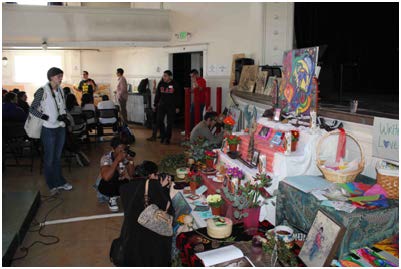
Thus far, these courses have generated more than 50 oral histories and at least a dozen short-form digital projects, some of which are now featured in the WWR Digital Oral History Archive. Several students have used this project to create their own documentary film projects, including Leah Michaels and Rozz Therrien’s about the grassroots, self-defense collective, Home Alive. The film debuted in fall 2013 at the MEOW Con festival in Austin where Michaels and Therrien joined a panel of Home Alive artists and activists. They also screened their film at the 2014 WWR Film Festival and spoke to our undergraduates in our large “Rock the Archive” class. Gender, Women & Sexuality Studies (GWSS) PhD student M. De La Torre produced a mini-doc about Radio KDNA, the only full-time Spanish language public radio station in the United States, while Barbie-Danielle De Carlo and Angelica Macklin produced the mini-doc to highlight WWR’s community-building process. Beyond these individual projects, students often become involved in the planning of the WWR conference or with the art and social justice organizations they have encountered in conducting their oral histories or attending WWR events. They learn by doing. As our students embark on careers in media, technology, academia, arts, and social justice advocacy, they return to show their work and teach and mentor our current students. In this way, the project has been generative for undergraduates and graduate students alike.
4. Graduate Mentoring
Of equal importance, since 2011, we have run a Women Who Rock Graduate Mentor Workshop, which is, in many ways, the heart of the project. In these workshops, ten to twelve graduate students from various disciplines present their work in progress and receive feedback from a range of established scholars and journalists with backgrounds in feminist performance, popular music studies, media studies, and meta-data/digital archiving practices. Past scholars, journalists, and filmmakers have included Daphne Brooks, Chicana and Women’s Studies scholar Maylei Blackwell, sociologist Andreana Clay, Mako Fitts Ward, filmmaker and educator Sheila Jackson H., Tiffany Ana Lopez, Tara McPherson, journalist Ann Powers, jazz scholar Sherrie Tucker, and ethnomusicologist Deborah Wong, among others. These seasoned practitioners work in the students’ fields of interest and are keenly engaged with the development of their research. The workshops provide an all-too-rare space for mentoring students, many of them women of color, whose research is not always legible within their own disciplines. Such exchanges also strengthen intellectual collaboration at the senior level. The workshop structure makes the most of invited guests’ expertise in both an intimate and public context. These relationships continue beyond the workshop, in the form of advising and advocacy.
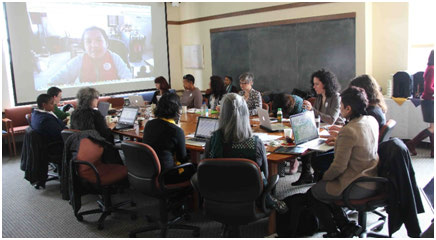
Our doctoral students have received prestigious pre-doctoral and dissertation fellowships. They have successfully matriculated and been hired into tenure-track positions, going on to connect their local communities with WWR.
These positive outcomes work against pernicious patterns within the academy. We are reminded of theorist Grace Kyungwon Hong’s reading of black feminist literary scholar Barbara Christian’s critique of academic knowledge production and its exclusion of women of color’s voices, queries, and findings: “Christian importantly connects the question of who has access to the university to the question of what kinds of knowledge are produced” (103). In her essay, “The Future of Our Worlds,” Hong contends that “changes in knowledge production are a precondition” for the greater representation of women of color scholars in the university. We have witnessed this in a very real way. If some of the graduate students mentored by WWR have moved on to the next phase of their careers, others are just joining us. In our collaborations with community arts programs and social justice organizations, we have encountered activists, artists, filmmakers, and other cultural producers who were interested in graduate degrees. Several have entered undergraduate and graduate programs in the past two years and will participate in the 2015 mentoring workshops. By creating an experimental platform for graduate students whose work is rooted in women of color feminist theory, WWR promotes the development of research that values community engagement and collaboration and public modes of scholarship and media production.
As GWSS PhD Calla Chancellor notes of the workshop:
[it] is a genuinely unique intellectual and creative space that, in my experience, is often desired but rarely achieved. To be able to present to such an impressive gathering of artists, thinkers, students and scholars is truly a rare opportunity either on or off campus. At the same time, to receive such demonstrably generous and supportive feedback about my research and writing in progress is something that almost all graduate students crave, especially those of us engaged in non-traditional and feminist research. If only more students could be so lucky.
Judy Tsou, Head of the UW Music Library, observes: “Some of the projects from last year have improved tremendously in their focus and depth, in large part due to the workshop mentors.” Tsou remarks on the richness of these intergenerational encounters and the importance of students showcasing their research for review as it unfolds over the span of several years. Everyone learns from each other, though the primary focus is always on the graduate students’ research and personal and professional development.
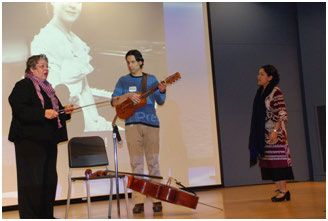
5. Community Engagement
In conjunction with the graduate mentoring workshops, we’ve organized three national conferences devoted to women, music, and community building and also an annual film festival. Since 2011, we’ve co-organized these conferences at Washington Hall with local music organization, Uzuri Productions, participants in the Seattle Fandango Project, Movimiento AfroLatino Seattle (MAS) and others (see the 2012 conference program for an example). Our conference keynote panels have featured performers such as Maria Elena Gaitán (Cholo con Cello), Alicia "Bag" Velasquez, Medusa, Nobuko Miyamoto, and Evelyn Harris.
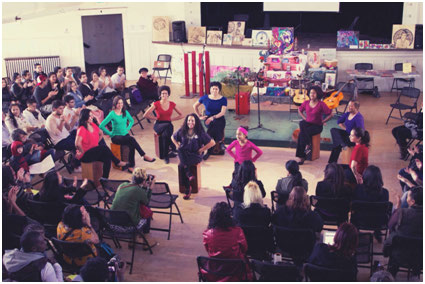
We digitally document each conference. Monica De La Torre created a radio kiosk to record participants’ audio stories, in addition to serving as a project manager. We have produced other modes of community-based scholarship and research through radio programming, performance, and digital scholarship (click here for samples of media projects). We continue to build relationships between the UW, the Simpson Center, and community organizations, such as Home Alive, Ladies First’s CARA, and Seattle Fandango Project. We continue to receive in-kind support from many local community arts and social justice organizations.
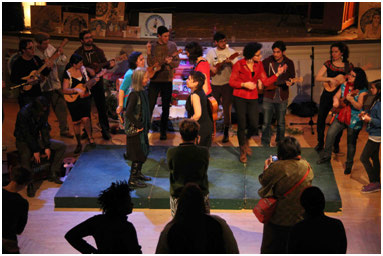
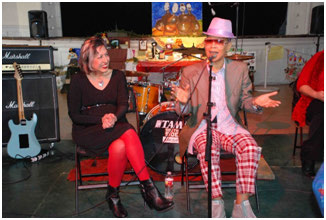
6. Archive
The WWR Digital Oral History Archive is the anchor that ties all of these components together. Here we feature archival content produced by students enrolled in our courses and provide content for new projects. In designing the archive, we have been inspired by feminist scholars of popular music who have had to create their own archives to tell untold stories, such as Farah Jasmine Griffin in If You Can’t Be Free, Be a Mystery: In Search of Billie Holiday (One World/Ballantine, 2002), Sherrie Tucker in Swing Shift: All-Girl Bands of the 1940s (Duke, 2000), Deborah Vargas in Dissonant Divas in Chicana Music: The Limits of La Onda (Minnesota, 2012), and Gayle Wald in Shout, Sister, Shout!: The Untold Story of Rock-and-Roll Trailblazer Sister Rosetta Tharpe (Beacon, 2008). Wald recounts how in the process of writing her biography of Tharpe she “became drawn to the mechanisms of historical memory, to the question of how certain figures—primarily racial-ethnic minorities and women—are rendered invisible” (158). Our archive too becomes a site for the subversion and transformation of the dominant “mechanisms of historical memory.”
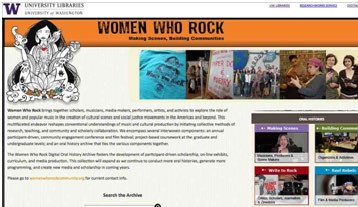
The WWR Digital Oral History Archive was developed in partnership with the UW Libraries Digital Initiative, in particular with Head Librarian Ann Lally, Digital Designer Angela Rosette-Tavares, and Computer Specialist Ann Graham. This archive is freely accessible to scholarly and general audiences. As we have focused on the process of building a collective digital archive that fosters community collaboration, we have come to understand from numerous angles the importance of rethinking the archive and its performative function. We are inspired by Diana Taylor’s argument: “by shifting the focus from written to embodied culture, from the discursive to the performative, we need to shift our methodologies.” Taylor writes of an expanded concept of the performance genre, one that “includes archives and repertoires, performatives and animatives in an effort to understand not just what we know but also how we know it—that is, to understand the politics of interaction, transmission, and exchange.” In celebration of our archive launch, we held a symposium that asked participants such as McPherson, Lally, Lopez, Tucker, and Wong to consider how these oral histories demand new forms of collective feminist archiving and meta-data praxis and potentially lead to new paradigms for popular music and new media studies.
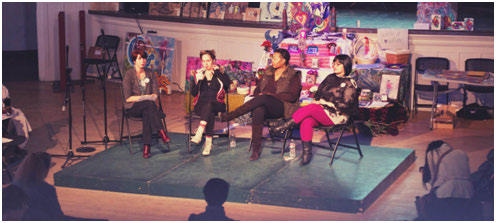
Since 2011, through curriculum, programming, and conferences, the scope of the WWR Digital Oral History Archive has grown. The form, substance, and process of the archive transform conventional notions of the artifact, pushing the evidentiary assumptions of popular music studies so as to rewrite the story of pop from a feminist, decolonial perspective. Significantly, the archive is a collective and collaborative project driven and sustained by relationships. It is a platform for documenting and fostering the relationships and networks that drive music scenes, social justice movements, collaborative research and writing, art making, and more. The archive does not simply cast back retrospectively to tell a static story of scenes and movements past, it also documents scenes and movements in the present. Indeed, in assembling the archive, we have created our own scenes, our own fluid community of inquiry. In this sense, it is a living archive, one that both reflects and generates alternative communal and creative networks and genealogies.

WWR as a whole demonstrates our efforts to discover new ways of producing knowledge among different groups of people who share common interests. As we stage physical spaces of convivencia—what scholar/artivista/musician Martha Gonzalez theorizes as the co-creation of social space—both within and outside of the university, we aim to create multi-generational, multi-genre musical experiences in community. These events hold together different musical worlds in a beautiful and rare way, providing a space for historically aggrieved communities to share techniques of resistance, survival, and joy, and learn from respected elders who rock across genre. At our 2012 keynote panel, Medusa, the Angela Davis of hip hop, emphasized the importance of documenting the conference and collecting oral histories of women in music so that many more contributors can “add their voice and their muscle” to the archive. And punk legend Alicia “Bag” Velasquez observed, “Unless you document your work, it’s as though it never existed.” Such claims fuel our efforts to create a space for women and their allies to build rich communities of inquiry that change the ways we think and “do” popular music studies at the university and in the community.
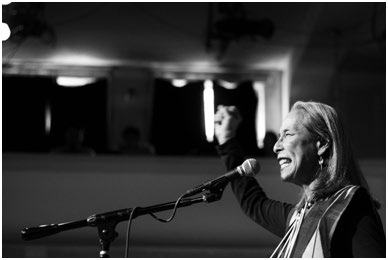
Works Cited
Bartha, Miriam. “Rock the Archive.” Walter Chapin Simpson Center for the Humanities Newsletter (2012-2013): 8-9. Print.
Brooks, Daphne A. “The Write to Rock: Racial Mythologies, Feminist Theory, and the Pleasures of Rock Music Criticism.” Women and Music: A Journal of Gender and Culture 12 (2008): 54-62. Print.
Gonzalez, Martha. “Sonic (Trans)Migration of Son Jarocho Zapateado: Rhythmic Intention, Metamorphis and Manifestation in Fandango and Performance.” ‘Cornbread and Cuchifritos’: Ethnic Identity Politics, Transnationalization, and Transculturation in American Urban Popular Music. Eds. Wilfried Raussert and Michelle Habell-Pallán. Trier: Wissenschaftlicher Verlag Trier, 2011. 65-78. Print.
Hong, Grace Kyungwon. “The Future of Our Worlds”: Black Feminism and the Politics of Knowledge in the University under Globalization.” Meridians: feminism, race, transnationalism 8:2 (2008): 95–115. Print.
Lopez, Tiffany Ana. "Conference Review." Journal of Chicana/Latina Studies 10:2 (Spring 2011): 198-205. Print.
Lothian, Alexis and Amanda Phillips. “Can Digital Humanities Mean Transformative Critique?” Journal of e-Media Studies 3:1 (2013): 1-25. Web. 1 Dec. 2013.
McPherson, Tara. “Women Who Rock Oral History Interview.” Women Who Rock Oral History Archive. U of Washington, 9March 2013. Web. 1 Dec. 2013.
---. “Introduction: Media Studies and Digital Humanities.” Cinema Journal 48.2 (Winter 2009): 110-123. Print.
“Rock the Archive: Popular Music Studies and Digital Scholarship Seminar 2013.” Women Who Rock Oral History Archive. U of Washington, 9Mar. 2013. Web. 1 Dec. 2013.
Taylor, Diana. The Archive and the Repertoire: Performing Cultural Memory in the Americas. Durham: Duke UP, 2003. Print.
---.”Remapping Genre through Performance: From ‘American’ to ‘Hemispheric’ Studies.” PMLA 122.5 (Oct. 2007): 1416-1430. Print.
Wald, Gayle. “Rosetta Tharpe and Feminist ‘Un-Forgetting.’” Journal of Women's History 21:4 (Winter 2009): 157-160. Print.
“Women Who Rock Oral History Archive Mission Statement.” Women Who Rock Oral History Archive. U of Washington, Mar. 2013. Web. 29 Sept. 2013.
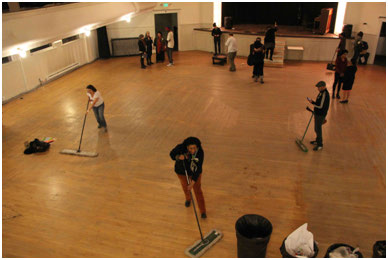
Images:
Figure 1. “Women Who Rock: Making Scenes, Building Communities, Homepage.” Womenwhorockcommunity.org. n.d. Screenshot. 8 June 2014.
Figure 2. Macklin, Scott. Women Who Rock unConference 2012 organizers at Washington Hall. Women Who Rock Oral History Archive. U of Washington, 9Mar. 2013. JPEG.
Figure 3. Lenahan, Colleen. Digitally documenting the Women Who Rock community altar 2013. Women Who Rock Oral History Archive. U of Washington, 9Mar. 2013. JPEG.
Figure 4. Macklin, Angelica. “Graduate Mentor Workshop 2013.” Women Who Rock Oral History Archive. U of Washington, 9Mar. 2013. JPEG.
Figure 5. Macklin, Angelica. Women Who Rock unConference 2011 keynote Chola con Cello with Quetzal Flores and Martha Gonzalez. Women Who Rock Oral History Archive. U of Washington, 9Mar. 2013.
Figure 6. Bublitz, Dana. De Cajon Project at the Women Who Rock unConference 2012. Women Who Rock Oral History Archive. U of Washington, 9Mar. 2013. JPEG.
Figure 7. Macklin, Angelica. Community Fandango with Seattle Fandango Project at the Women Who Rock unConference 2013. Women Who Rock Oral History Archive. U of Washington, 9Mar. 2013. JPEG.
Figure 8. Macklin, Angelica. “Alicia Bag and Medusa keynote Women Who Rock unConference 2013.” Women Who Rock Oral History Archive. U of Washington, 9Mar. 2013. JPEG.
Figure 9. “Women Who Rock: Making Scenes Building Community.” Women Who Rock Oral History Archive. U of Washington. Screenshot. 9Mar. 2013.
Figure 10. Bublitz, Dana. “‘Rock the Archive: Archive as Creative Source’ Panel featuring Gretta Harley of Home Alive and These Streets Sheila Hardy film director of Nice and Rough, and Kitty Wu of 206 Zulu.” Women Who Rock Oral History Archive. U of Washington, 9Mar. 2013. JPEG.
Figure 11. Macklin, Scott. Girls Rock at Women Who Rock unConference 2012. Women Who Rock Oral History Archive. U of Washington, 9Mar. 2013. JPEG.
Figure 12. Bublitz, Dana. Women Who Rock unConference 2013 keynote Nobuko Miyamoto. Women Who Rock Oral History Archive. U of Washington, 9Mar. 2013. JPEG.
Figure 13. Macklin, Angelica. Washington Hall clean up after Women Who Rock unConference 2013. Women Who Rock Oral History Archive. U of Washington, 9Mar. 2013. JPEG.



